If you’re a small business owner or work in a small business, you know that you need to start doing some digital marketing, but you have no idea where to start.
It can feel overwhelming trying to figure out what kind of digital marketing will work best for your small business.
How do I write a digital marketing plan?
Do you start a blog?
Should you invest in paid ads?
What’s the difference between organic and paid search engine optimisation?
The good news is that I can help!
I’ve put together this guide today, and we’ll walk you through everything you need to create your own digital marketing plan for small business.
We’ll show you how to identify your target audience, choose the right channels, develop your messaging, and track your results.
What is a digital marketing plan?
The purpose of marketing planning is to develop activities that will support business goals and set a timeline for the completion of those activities.
As always, the conversation should be rooted in your small business marketing strategy. – this represents your “why” and keeps you and your team on track.
During the planning process, you will need to identify the “when” and “what” of the marketing work to acquire, grow, and keep customers.
And your marketing plan outlines these details.

Planned marketing helps team members communicate dates and deliverables, because it allows everyone to coordinate one timeline.
Depending on the type of work, you can create different marketing plans.
To convey progress against the company’s goals, executives and other stakeholders can also provide a high-level view of the marketing plan.
I find it helpful to use marketing plan templates to create a repeatable planning process.
As a small business, you don’t have the time or dedicated marketing team to thoroughly plan and research an impeccably devised plan that requires a Chief Marketing Officer (CMO) sign-off.
You can create a one-page marketing plan that you can refer to and guide you along as a small business.
DEFINITION
A digital marketing plan is a document in which you strategically map out your digital marketing objectives, as well as the actions you’ll take to achieve those objectives.
Among other things, digital marketing plans outline the online channels you can use to reach and communicate with your target audience.
Such digital channels as online advertising, search engine optimisation, email marketing, and social media.
The plan would also include business goals, the digital strategies you’ll use to meet those goals, an analysis of the competitive landscape, timelines, budgets, digital channels, and more.
A digital marketing plan can be viewed as a roadmap of sorts. You are given a specific route to follow to get to your destination in the plan.
Why is it so important to have a digital marketing plan?
The data shows that recording your strategies increases the chances of your business succeeding, with 69% of B2B marketers using a documented content strategy. Providing step-by-step instructions for achieving goals is part of an accurate plan. Here are some of the main benefits that your business can gain from a marketing plan.
- Know who your target audience is – Defining your target audience begins with research. Having a specific target audience can help you understand the behaviour of your customers and adjust your sales model accordingly. You can also speak one language with a customer and provide genuine assistance during the buyer journey.
- Use of resources efficiently – By having a plan, you can avoid wasting money on things that are not necessary for your business. Having clearly defined deadlines in your marketing plan can also help you manage your time appropriately.
- Each department should work in the same direction – your company’s team can communicate and move in the same direction when each member has access to the plan as a coordination tool.
Therefore, a digital marketing plan can help you achieve your objectives and benefit from your small business. Next, we will cover the methods of a digital marketing plan.
Marketing methods for your digital marketing plan
As a small business marketer, you’ve got to be prepared. You’ve got to know what tools will bring your company or client the greatest return on investment (ROI) before even thinking about writing an online marketing plan.
How do I figure out which of these many new and exciting digital marketing techniques is right for me?
Advertising
Ads on third-party websites, like blogs, forums, and other relevant websites, can be purchased and sold online by bidding on the ad units for those sites. Images, text, pop-ups, banners, and videos are all forms of advertising.
A retargeting campaign is one of the most effective ways to advertise online.
When visitors visit other websites, you can serve them ads for your product or service. You can then target your advertising efforts towards people already interested in your company.

In the above image, you will see an example remarketing ad from Yoox, one of my favourite online clothing stores.
As a demo, today I looked at a fancy Dolce & Gabbana blazer on Yoox.
I then went to another website, namely Hello! Magazine, and within seconds I was shown an online advert for the exact same D&G blazer! How spooky!
If I now visit another website with display ads (see below), I will be shown the same online advert again! This is a perfect example of how remarketing online ads work.
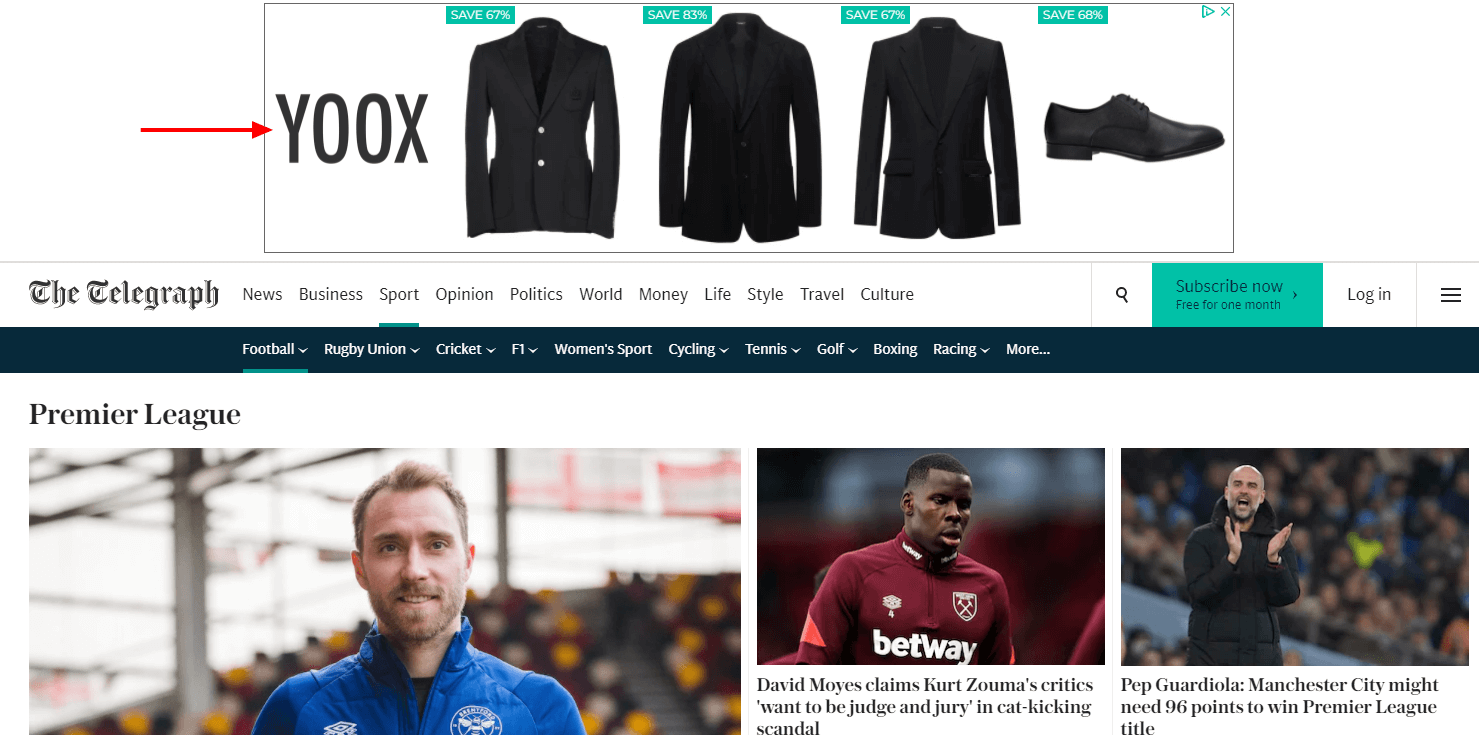
Content marketing
It is helpful to use content marketing to attract potential customers. Developing thought leadership requires a regular stream of high-quality, relevant content online. Content marketing campaigns are also known as inbound marketing campaigns. The opposite of Inbound is Outbound Marketing, which is things like direct email marketing or sales calls.
Besides boosting SEO rankings, it educates your target customers about the problems your product or service can help them resolve. Creating content that provides value to your target audience can include blog posts (like this one), case studies, podcasts, whitepapers, infographics and other materials. Content marketing is easily shared via social media, making it great to get noticed. Through organic and paid efforts, digital content assets can acquire customers.
Here is a great example of content marketing from HubSpot’s resource page. They provide tonnes of helpful resources, which help HubSpot collect email addresses, which they then use to nurture prospects into customers.
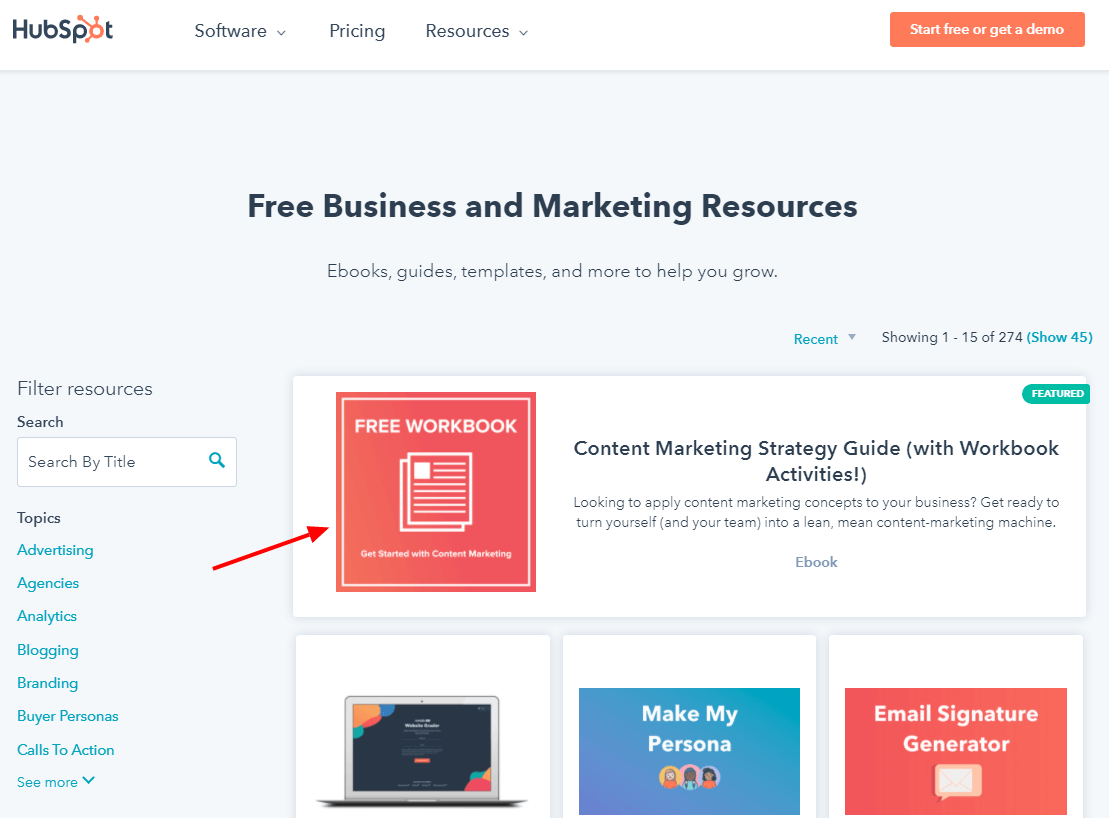
Email marketing
Direct marketing methods involve sending promotional email campaigns to a segmented list of prospects and customers. Marketing via email remains an effective way to send personalised messages that target customers’ needs and interests. eCommerce businesses are most likely to use it to stay top-of-mind with consumers with offers and product news.

Influencer marketing
Influencer marketing is the concept of having a social media influencer promote a brand’s products. Influencers often mention and endorse brands to improve brand recognition. As a reward, the brand pays them or provides free products. A social media influencer is someone who has gained credibility in a particular niche. YouTube influencer marketing, Instagram influencer marketing, and other social media platforms are examples of influencer marketing. There is a devoted following of social media influencers – people who value their opinions, tastes, or lifestyles. As a result, they directly affect what their followers buy and influence their purchasing decisions, hence the term influencer marketing.

For example, here’s an influencer campaign for Olay by amra & elma.
- Problem – A Broadway musical organised by Olay showcased its newest skin care lines for various skin types, from oily to dry. They wanted to create a campaign that would raise awareness and make Olay more relevant to urban millennials.
- Solution – Influencers were hired by Amra & Elma to boost ticket sales and promote the skincare lines while preparing for the show, during the show, and after the show. All the tickets were sold out, and the audience was so thrilled they used Olay’s hashtags #OlayLive #RoadtoGlow even after the show.
- Statistics – A total of 10 influencers (micro, mid-level, and macro), 200+ organic posts, 1.5+ million estimated impressions, and 160K estimated engagements.
Link building
Link building refers to the process of acquiring links from other websites to your own website. Building links is essential, because it is a major factor in the ranking of a web page by search engines such as Google. Your website’s link tells Google that it is an authoritative resource on the topic and should be cited. Google tends to rank sites with more backlinks higher. That’s what SEOs call “link juice”.
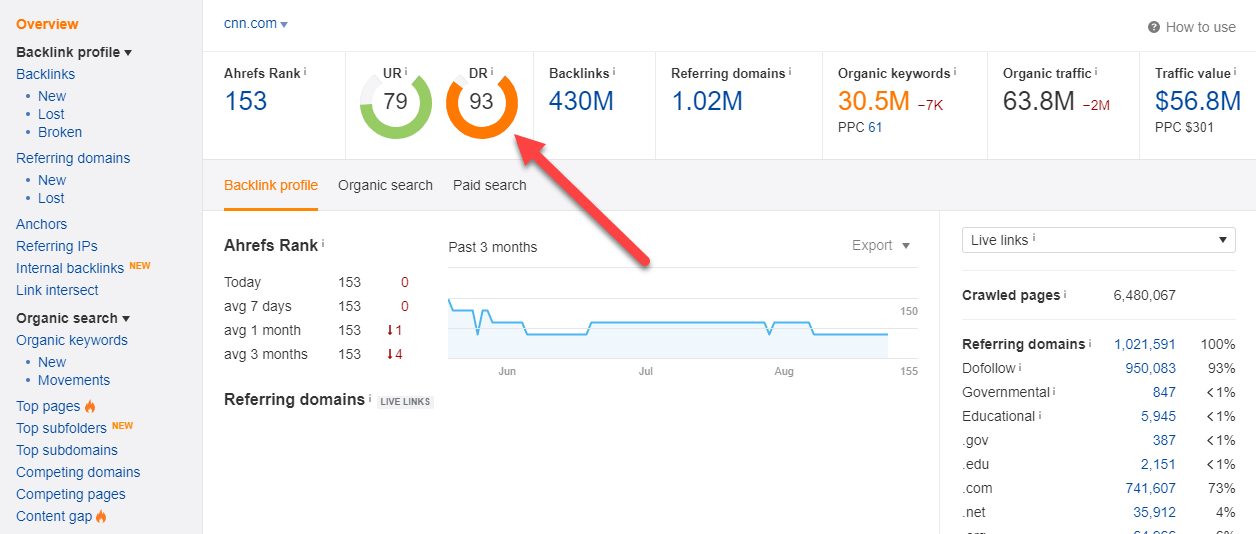
Local SEO
Local SEO stands for “local search engine optimisation,” and any business knows that attracting local customers can be the difference between success and failure. As a result, local SEO uses search engine optimization and local business directories like Google Business Profile (formally called Google My Business) and Google Maps as tactics to specifically target these valuable local customers. Local SEO helps people physically visit the business by increasing phone calls and traffic to the website.

Mobile marketing
Mobile marketing aims to promote products and services, specifically through mobile devices. Such marketing includes mobile advertising through text messages and app advertisements. A comprehensive mobile marketing approach includes optimising websites, besides optimising landing pages, marketing emails, and engaging content for mobile devices. Generally speaking, mobile marketing is a thought process you use within all your marketing, since more people use their mobile than desktop, especially in B2C.
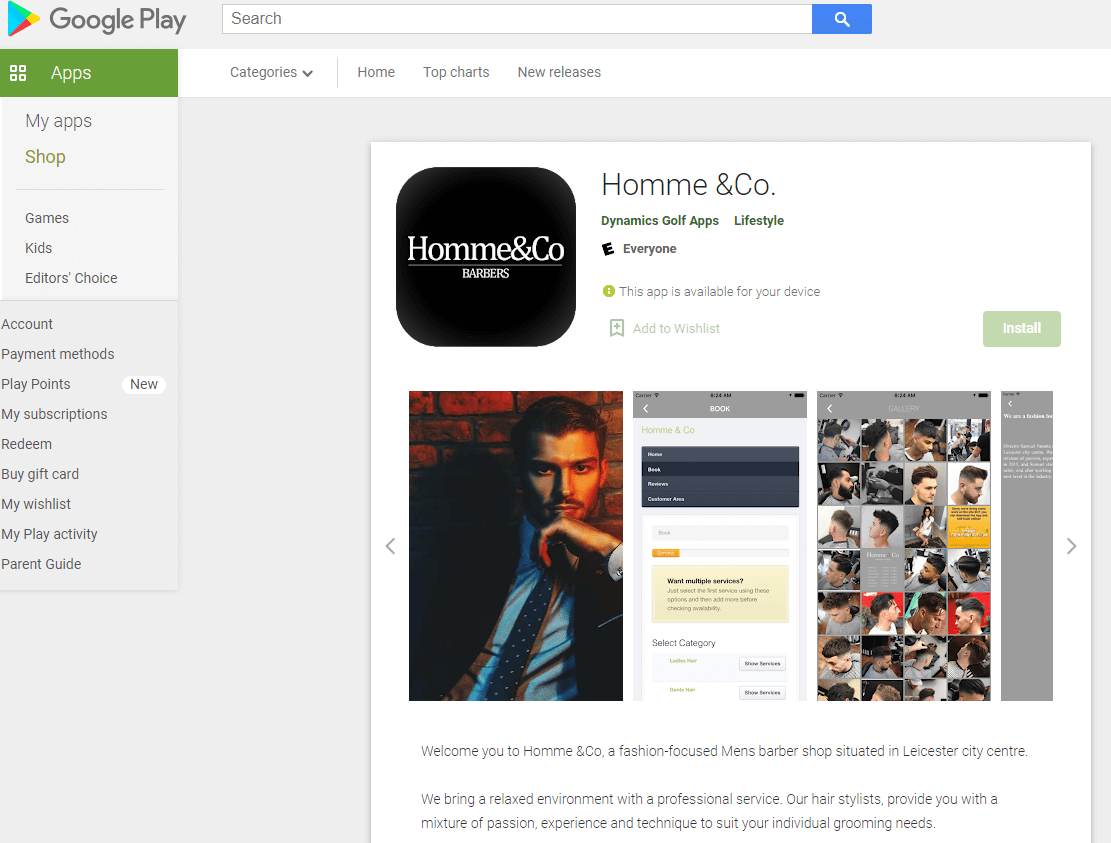
The image above is a screen shot from one of our clients’ Homme & Co in Leicester. Many years ago, I built this mobile app for them, which you can find on Android and Apple.
Search engine marketing (Paid search)
Search Engine Marketing (SEM) allows companies to buy advertising space in search engine results by bidding for specific keywords. You will only see ads if users actively search for the keywords you’ve selected. Pay-per-click (PPC) and cost-per-thousand (CPM) are the two main types of paid search advertising. Note – The “M” in CPM represents the word “mille,” which is Latin for “thousands.” A PPC ad only costs you when a customer clicks on it. A CPM ad only costs you when the customer sees it. Other search engines, such as Bing, also have paid search advertising programs via the Microsoft Advertising Network. Google Ads (formally Google AdWords) is the most widely used paid search advertising platform.
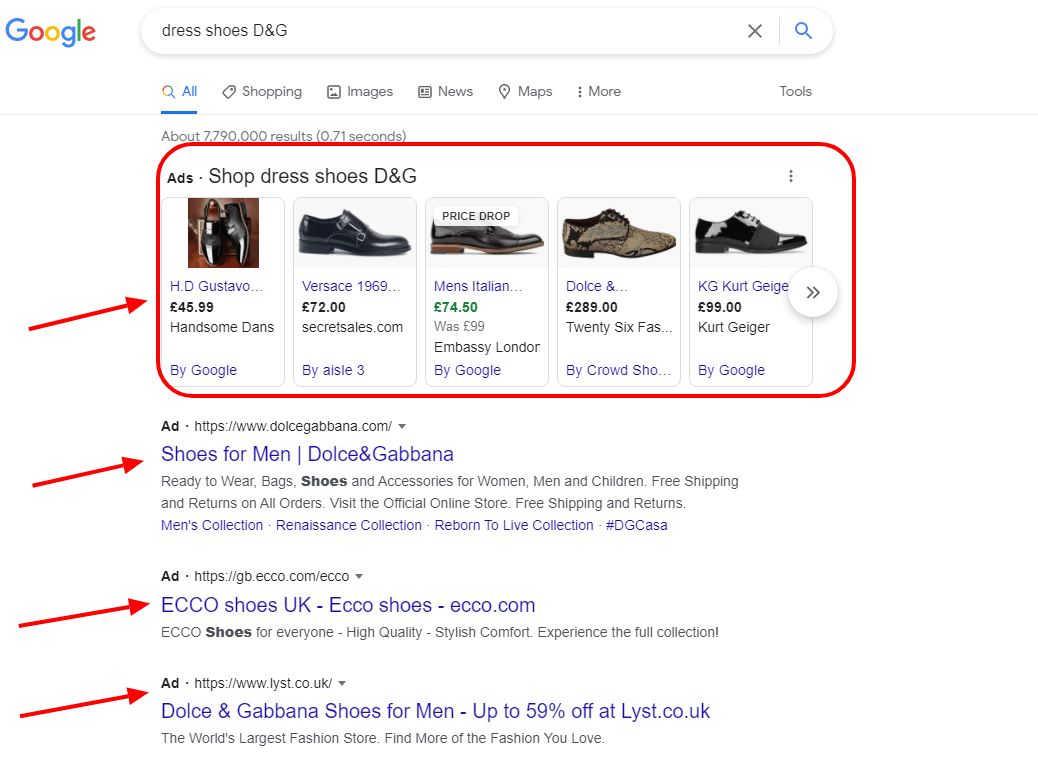
Above is an example of Google Ads, for the search query “dress shoes D&G”. Note that Google displays results in the Google Shopping snippet at the top of the search engine results page (SERP), then shows PPC 3 ads.
All this information is displayed before the organic results, which is why search engine marketing is so effective.
If I now click on one of these ads, it will take me to the landing page and will cost the advertiser money for that one click, even if I don’t buy anything. If I click on one of the organic results further down, there is no cost to the website owner for that click.
The key benefit of search engine marketing for businesses is that paid ads offer higher conversions and better Click Through Rates (CTRs) than more passive forms of marketing. Due to PPC’s ability to be customised, it enables you to target specific keywords aimed at your target audience.
Programmatic advertising
In digital advertising, programmatic advertising is an automated bidding method. Each time someone visits a webpage, ad impressions are auctioned to other competitors based on the profile information displayed. You can better target your ads with programmatic advertising, because you have more control over what sites your ads appear on and who sees them.
Referral marketing
Referral marketing is closely related to word-of-mouth marketing. Existing customer and brand advocates can help you promote your products. It is common for people to refer their friends and family to a product or service that they enjoy. Consumers are more likely to trust the opinions of real people than those of brands themselves. To me, this is the pinnacle of marketing in many ways. There is nothing better than if a brand has people who already love its products and will share their positive experiences with the world.
Reputation marketing
An important aspect of reputation marketing is gathering and promoting positive online reviews. Internet reviews can influence customer buying decisions and contribute to your brand name and product reputability. Customers are encouraged to leave positive reviews on sites where potential clients search for online reviews as part of an online reputation marketing strategy.
Search engine optimisation
Optimisation of your website through search engines (SEO) improves organic traffic. Search engine optimization activities encompass technical and creative tactics to improve search rankings and increase visibility. Search engines such as Google, Bing, and Yahoo are the most widely used. To maintain a strong ranking, digital marketers optimise the pages with keywords, internal links, backlinks, and original content.
Social Media Marketing
Digital marketing includes social media marketing. You can reach and interact with potential customers through Facebook, Twitter, Pinterest, Instagram, Tumblr, LinkedIn, and even YouTube. Efforts in digital marketing campaigns often combine organic marketing efforts with sponsored content and paid media promotions on key social media platforms in order to reach a larger audience and increase brand awareness.
Video marketing
To engage customers visually and interactively, companies use video marketing. As well as educational content and testimonials, you can display product launches, events, and special announcements. Videos are commonly shared and advertised on YouTube and Vimeo. Video pre-roll ads (shown in the first few seconds before a video begins) are another way for digital marketers to reach audiences on video platforms.
Web analytics
Marketing managers can track online user activity using analytics. Data collection and analysis are fundamental to digital marketing, because they provide insight into customer behaviour and preferences. Google Analytics is the most widely used tool for analysing website traffic. Still, there are other tools, such as Adobe Analytics and others.
Webinars
A webinar is a virtual event that allows companies to interact with potential and existing customers. Online webinars effectively present relevant content – such as a product demonstration or seminar – to a targeted audience in real-time. Directly engaging with your audience allows your company to demonstrate deep subject expertise. Attendee lists are used in other marketing programmes (emails and retargeting ads) to generate new leads and strengthen existing relationships.
Read on to discover the following steps involved in creating your first strategic digital marketing plan:
How to create a digital marketing plan for small business
As mentioned previously, small businesses can use various digital marketing methods to engage potential customers. However, it is crucial to invest in the channels and media that help you acquire, grow, and retain customers.

Here are some questions that can help you identify suitable digital activities to include in your plan:
- What are your business goals and business aspirations?
- What are your marketing objectives?
- How much money do you have to spend on digital marketing?
- Who is your target audience?
- How would you describe your audience?
- What online channels does your audience use?
- What are the outcomes you want to achieve for your customers?
- What benefits do you want to promote?
- What alternatives would your customers choose?
- What changes need to be made to improve the customer experience?
- If digital marketing is used, how will that improve the customer experience?
- What data is required to better understand customer behaviour and preferences?
- What metrics will measure success?
- To whom does your plan need to be shared?
Now you have a list of questions and detailed answers. Here’s a look at the steps you can follow:
Step 1: Business objectives
The business objectives supersede everything else. It helps set the broadest parameters for the work you are doing. We continue to ask questions and map out answers to develop a framework.
Think about your website and ask yourself another question: why does your website exist?
Consider your visitors’ acquisition, behaviour, and the outcomes you want from them.
Acquisition
What are your plans for acquiring traffic for your website / YouTube videos / social media posts, organic traffic via SEO, and whatever else you are creating?
Did you cover all components of a successful acquisition: Earned, Owned, Paid? Which would you prioritise? Where are you spending most of your efforts?
If your business objective was to physically attract more people to the business, i.e., Footfall, then again, what are your plans for promoting the company that will encourage people to visit?
Behaviour
What behaviour do you expect people to exhibit when they arrive at the website? Which pages should they see? Which videos should they watch? Should they come back? What actions do they need to take? How does your effort relate to an optimal experience for a customer?
Outcomes
What outcomes signify the value delivered to the business bottom line? Perhaps a download? Customer service calls? An online lead? Signing up for newsletter emails? Are people buying your product? Improve their lead score by 10 points?
To complete this step requires some deep thinking.
You might be familiar with SMART objectives, meaning Specific, Measurable, Achievable, Relevant and Timely.
As with most popular management tools, there is no science behind this. There have been successive mutations in the original meme.
But another option to consider is DUMB objectives.
- Devious
- Unfair
- Manipulative
- Bizarre
Or you can think of them as
- Dream-Driven
- Uplifting
- Method-Friendly
- Behaviour – Driven
Alternatively –
- Doable
- Understandable
- Manageable
- Beneficial
Choose what resonates with you, so you can get it done!
Step 2: Identify and set your digital marketing goals
A digital marketing plan must have a purpose before it can be created. Your marketing goals should be aligned with your objectives.
This goal is determined by your long-term goals. Set long-term goals, and then break them down into smaller goals. As such, your goals should be measurable.
Goal examples may include:
- Generating clients for the new product or service that you are about to launch
- Increase the loyalty of existing customers by a certain percentage
- Increase the number of times your product is mentioned favourably online
- Build brand awareness
- Generate leads
- Promote your local business
- Sell products online
- Create an online presence
- Increase traffic to your online store by a certain percentage
Again, if we consider your website goals, it is worth considering the DUMB acronym.
For example, your website objective is to create awareness to generate leads used to Sell Services.
Your website goal for that objective would be to start 1) Online Advertising Campaign, so you can 2) Capture Email Addresses and Contact information, which you will use to provide the prospect with 3) Reliant Information and Resources, with a goal of 4) Making Revenue.
Therefore, to make revenue, you will need to create critical top-of-the-funnel marketing content that helps your sales team start more conversations with prospects for lead generation, and spend some £ on advertising budget with Google Ads or Facebook Ads to find the prospect.
Step 3: Examine your situation
A SWOT analysis can help you better understand the situations that may arise while marketing your business.
Your company’s strengths set it apart, while its weaknesses allow business growth.
External factors, such as the economy, competitors, and technology, influence your opportunities and threats.
For example, SWOT analysis for digital marketing might include a keyword gap analysis for your website. This is part of your keyword research.
This means you can identify specific keywords where competing websites are performing well, but you are not.

Marketing strategies can be improved while overcoming uncontrollable obstacles.
Create customer personas to help identify your ideal customers. This will help you with your research.
Therefore, for a successful digital marketing campaign, you first need to know your target audience.
Suppose you segment your audience and develop a buyer persona for each segment. In that case, you gain insights into what types of digital marketing will be most effective for your business.
You might sell high-end beauty treatments, for example. Your target audience may be females with an income of more than £40,000 a year and based within 20 miles of your business.
Alternatively, you may wish to sell new male grooming products online to affluent modern guys. Therefore, males who take personal pride in their appearance follow certain online Instagram accounts or Facebook pages and have recently purchased online.
The buyer personas and marketing strategies for each segment will differ according to the segment.
Suppose you want to communicate with the head of a manufacturing department of a large company. If that’s the case, your message is unlikely to resonate with small business owners.
Identify the different segments of your target audience in terms of their age, gender, and interests.
Within each segment, construct personas of the ideal customers for your business.
Your buyer persona information will differ depending on your product or service price, and whether your business is B2B or B2C.
The following are the basic quantitative and qualitative information you should include in your buyer’s persona, regardless of your business classification.
- Location – Where do you find your ideal customers? Are you primarily serving local customers, or are you available online to a broader audience? By using analytical tools, you can figure out where people find you in search results or where they visit your website.
- Age – It is possible that this information does not apply to your product or service if it is not age-specific. However, it’s still important to know what age trends exist in your existing customer database. The types of content people respond to and the marketing channels will differ according to their age.
- Gender – Gender even plays an important role in your buyer persona. This could be product or service-specific, which is gender-relevant, or your campaign imagery or language used, which is gender-specific. Some businesses may need to consider people who don’t associate themselves with gender.
- Income – When you learn about the income, you can determine if you target the right audience whose income you can afford your products or services. Online forms may not ask for income details, so research interviews may be more effective in obtaining this information. Yet, business revenue is common in business marketing, and data on company turnover can be readily collected from data sources.
- Careers – These might be the types of careers your existing customers have or people you hope to attract. You will want to include a person’s job title in making purchase decisions relevant to what your business offers for B2B businesses.
- Goals – We are now diving into the psychographic information of your buyer persona. Your customers may already be clear. To confirm this, speak to your customers or gather insight from your customer service representatives and internal sales team.
- Challenges – You must understand the pain points of your customers and the challenges they face. You can solve this challenge for them or help them decide who to purchase from by offering your product or service.
- Priorities – Understanding what is most relevant to your customers is essential. Is that the price? Did the customer service department respond quickly enough? What are the main things your existing and potential audience considers before purchasing a service or product?
- Interests – Your content will speak to your target audience if you know their hobbies and interests. It may seem obvious to you, for example, that your personal training business will have customers who want to get fitter and healthier. Consider whether there are other common interests. Do most of your customers eat well and understand calories? Then content describing ways to count and track calories would be effective.
Step 4: Identify Key Performance Indicators
To achieve success, you will need to track several KPIs, i.e., Key Performance Indicators.
KPIs are metrics used to measure the success of your digital marketing campaigns.
For an online store, the acquisition cost of a new client for your eCommerce website is an example of a KPI. i.e., how much did it cost you to acquire that customer? Include the cost of the ad, etc.
You can use a key performance indicator (KPI) to understand your performance against your goals.
For each goal, work out what KPIs you will use to measure how well you are doing.
Therefore, the KPI will be Newsletter Conversions to capture leads for our Newsletter. i.e., website visitor numbers and how many signed up for the newsletter.
Later, you can work out sales KPIs. If you know, every weekly newsletter sent to 1000 people generates 10 sales and you know 1 in 50 new visitors to the website convert to a sign up to the newsletter. Therefore, to double your sales income over the following period, you would need 100,000 website visitors.
Likewise, if you want to determine what the cost per qualified lead is, let’s start with simple maths:
Total Number of Qualified Leads Generated in Last Period (usually a year) / (divided by) the total marketing expense to get those leads = £Cost per Qualified Lead. £10,000 / 100 qualified leads = £100 / qualified lead.
You would average eight new leads a month if these leads were gathered over a year. We do not yet know whether £100 per qualified lead is good or bad. To scale your business, you will need to determine your Acceptable Cost per Lead.
Based on the example above, your marketing team will receive about 8 marketing qualified leads per month. If your sales team closes 25% of those leads, you will make two sales per month.
There are 8 leads, but none are yet a Sales Qualified Lead.
Let’s keep it simple: 8 Qualified Leads / 5 New Opportunities = 62.5% Qualified Lead to Opportunity Conversion Rate.
As a result, the remaining 3 qualified leads need to be nurtured by marketing, since they are not ready to buy your solution (service or product).
You can now finalise your model with the data you have already collected.
Determine the average value of each sale by looking at all sales over the past year. Let’s assume the average sale is £5,000 over a year.
Analyse the results of your digital marketing and sales machine to determine how well your business is doing. The following data will help you create a successful inbound marketing strategy.
- £100 cost per qualified lead
- 8 qualified leads per month (£800 per month)
- 5% Qualified lead to opportunity rate
- 5 new sales qualified leads per
- 25% close rate on sales qualified leads
- 1 new sale per month (12 per year)
- £5,000 avg. value per sale
Suppose the above numbers are averaged over a year. In that case, your digital marketing team will deliver: Although these numbers are slightly off because of rounding down, you get the idea.
- £9,600 spent to get 96 qualified leads
- 48 new sales worth £240,000 (accrual basis)
Once you clearly understand the fundamental marketing metrics you use, it’s time to continue with your digital marketing strategy-based plan.
It’s OK if you go a little slower than you would like to at this crucial step.
If done correctly, building a plan should be a process that allows you and your team to discover (or rediscover) who you are and why you do what you do for your customers.
It’s not only about making money.
Of course, that is part of it, but your plan should be based on your business and its delivery.
Step 5: Consider your budget
Before proceeding further, consider your budget.
Many companies will spend millions of pounds on marketing every year. Still, not every business can do so, especially a small business.
Regardless of what you decide to spend, you need to make sure you can afford it.
According to recent report data, digital advertising budget optimism has increased significantly since the beginning of the global COVID-19 crisis, as more people and businesses moved online.
According to budget trend survey data from Kantar and MarketingCharts, 76 per cent of marketers plan to expand their media budget for digital video content during 2022.
This is the top area of media expansion, followed by influencer content at 71 per cent and social media story ads at 70 per cent.
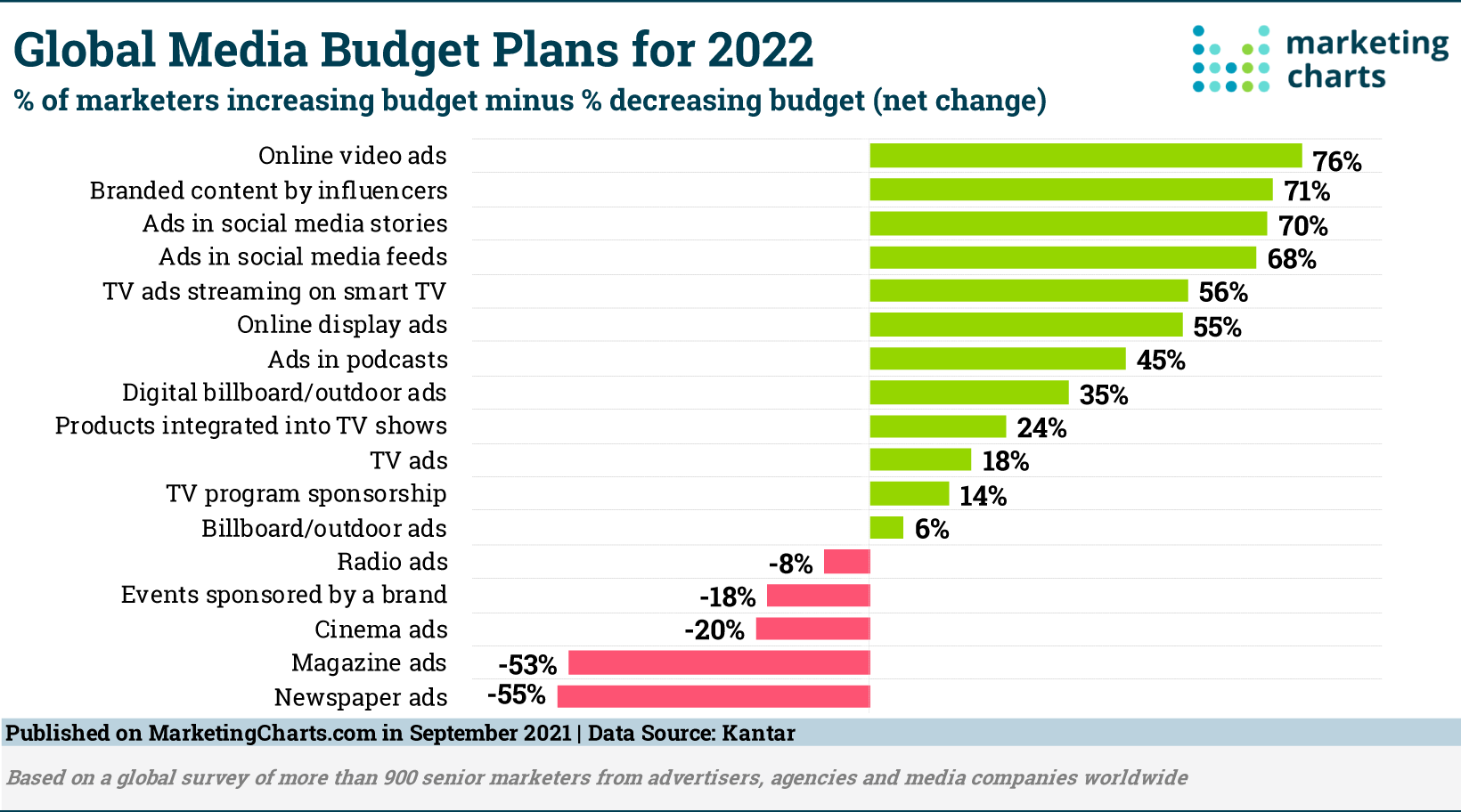
Measuring what works and isn’t is critical to learning about growth opportunities.
Budget decisions are more manageable when you have accurate performance data at hand.
However, many companies of all sizes struggle with data overload or lack relevant performance data.
To create a successful marketing budget plan, you need to adjust it on the fly based on industry changes. This is often accomplished by having it reviewed every year, quarterly, monthly, or even more frequently.
It is important to set strategic and channel directions, work toward commercial goals and KPIs, and monitor success.
However, if you don’t track your ROI per channel, it is difficult to understand how much money you have spent to get results. You need a budget that is practical and accessible.
For example, keep your options open so that you can take advantage of opportunities to improve your online advertising ROI. If a campaign isn’t producing a positive return, you might want to eliminate it.
It is also wise to consider shifting budgets and allocating more money to a certain campaign (or channel) if you see it consistently producing outsized results.
You only raise the budget and keep your acquisition amount lower than your target when you have a specific return-on-spending goal in mind that is highly profitable.
Small businesses struggle to succeed in certain digital marketing channels simply because their budgets are too low, especially at the beginning stage.
Running online ads, for example, requires at least a minimum spend of £10-£20+ per day.
However, if you can budget the minimum spend and make the first few ad campaigns a success, invest that income back into your ad campaign and double down on your investment.
Again, run the campaign and reinvest your 3rd new income back into the campaign until you can at least triple your original daily spend.
Using this method, your marketing budget can be used dynamically and evolvingly, which is great for your digital marketing campaigns. It allows you to compete and reach your target audience.
Step 6: Define your digital marketing channels
It is important to define the primary digital channels you will use before developing a content marketing strategy. Your chosen medium should be based on your objectives, audience, situation, goals, and budget.
Let’s say your aim is to promote your local business, and your goal is to reach more customers near your store.
In that case, you can use Facebook and personalised Facebook ads as your digital marketing channel. This will boost local traffic and sales by reaching out to more people in your surrounding area.

Facebook is free, and Facebook ads aren’t too expensive and work great for finding local customers.
Using Facebook could be an ideal channel to leverage for this business objective.
In the example above, the other option I would suggest is the optimisation of your Google Business Profile.
Google Business Profile is an excellent tool. It’s a free service and perfect for local small businesses.
It works like an online directory, but is integrated into Google Search and Google Map.
Keyword queries like “near me” or keyword searches in Google Maps trigger the Google Business Profile Knowledge Graph and Maps’ pack to show businesses nearby based on the search query. For example, “best Thai restaurant”, “plumber Leicester” or “solicitors near me”.
Over 50% of ‘near me’ searches result in a store visit.
If you were the business owner of one of those businesses, you would want to be high on the Maps pack list and get that call or traffic to the website, wouldn’t you?
Consider where your audience spends the most time online when defining your digital channels.
If you are in the B2B industry, you might want to consider using LinkedIn or webinars.
It may make sense to consider influencer marketing on Instagram.
Use the channels your audience prefers and deliver value to them.
You will probably want to generate leads, raise brand awareness, improve conversions, and so on.
Ultimately, you want to get more sales.
You can create a mix of strategies by working with your digital marketing agency to target one or more of those objectives.
Please revert to the marking methods we covered earlier for details of different marketing channels. But in general, for small businesses, the following digital marketing channels need to be considered:
- Content Marketing strategy: eBooks, whitepapers, lead magnets, resources, blogging, content for SEO
- Email Marketing channels: email signatures, email lists, banners, newsletters, shopping carts, etc
- Social Media channels: Instagram, Facebook, LinkedIn, Twitter, online community bulletin boards like Facebook Groups, Facebook Live etc
- Websites: Your own website
- Referral Channels: Directories, websites that reference your page/company, etc
- Organic Search (SEO): Appropriate title tags, meta descriptions, keywords, etc., for on-page SEO. Backlinks for off-page SEO
- Local SEO: Local pages on a website, local ads, reviews, Google Business Profile, Google Maps, Citations
- Paid Search (SEM): Google Ads, Facebook Ads, Microsoft Ad Networks
- Mobile: Mobile apps, mobile websites
- Display Ads
- Affiliate Marketing
- Video Marketing
- Referral Marketing
Therefore, different digital marketing channels work differently and will yield different results.
You may also find that what works for one brand or small business won’t necessarily work for you.
It is ideal for testing various channels and strategies to determine which one works best.
If you are unsure how to successfully implement one or more of the suggested channels, please contact us, as that’s what we do.
Step 7: Plan your marketing schedule
To determine exactly when your digital marketing campaigns should be implemented, use this calendar in your marketing schedule.
Thus, you will be more likely to meet deadlines and execute the plan effectively throughout the year if you follow these steps.
Additionally, you should ensure that you consistently reach each of the segments of your audience throughout the year.
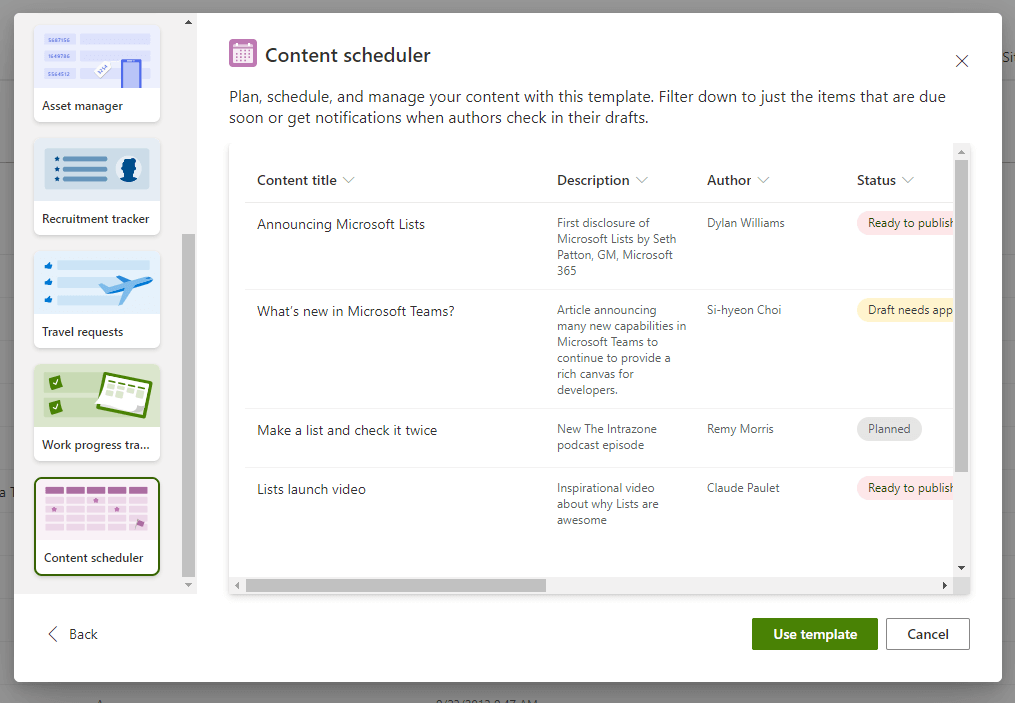
Plan your year by breaking it down into each month of the year and planning 12 months in advance.
As a result, you will have an overall framework and enough time to prepare and execute each delivery.
Each campaign is effectively a project, with start and endpoints and many tasks.
If you’re familiar with project management, then this will feel comfortable. If not, keep things simple.
With a marketing calendar, you can plan and organise your marketing projects in one place.
Here is your roadmap for all your marketing initiatives. For all marketing functions, it is a single source of truth.
A great way to start your marketing schedule is to brainstorm your content ideas. This does not have to be a daunting task. You can develop powerful campaigns and topic ideas in under an hour.
Find a way to prioritise your digital marketing ideas and campaigns. This could be based on the scoring system you devise.
Start with high-quality content that generates sales. You can then focus on brand recognition, because you’ll have some resources for the lead generation process.
You’ll also need to plan out who will get what done… if you are a small team, you might need help from outside marketing agencies, freelancers or other IT, graphic or content specialists.
Remember, outside influences that you can piggyback your digital marketing campaigns on, like seasonal events such as Christmas, Valentine’s Day, Black Friday, or critical sporting events.
You may find more relevant local or niche events for your industry that you can tie into your campaigns.
Be flexible and ready to run campaigns on the fly if you try Newsjack, which involves injecting your ideas into a breaking news story to get your message noticed.
Don’t forget PR campaigns and charity involvement.
At Dynamics Tech, I use Microsoft Planner and Microsoft Lists as our digital marketing tools to organise and collaborate on our marketing campaigns. I would then use tools like Buffer for social sharing ready to go completed campaigns and ActiveCampaign for email marketing.
Step 8: Measure the results
Even though we covered KPIs in step 4, it’s now important to measure the KPIs you identified and compare the results of your marketing efforts against the baseline and the original goals.
Measure again if the results are underwhelming, and then make adjustments and optimise again.
As a marketer or owner of a small business, measure each channel to identify what works best for your brand and what you didn’t do so well, so you can learn from it.
With this knowledge, you now understand the steps to consider when developing successful digital marketing strategies for small businesses.
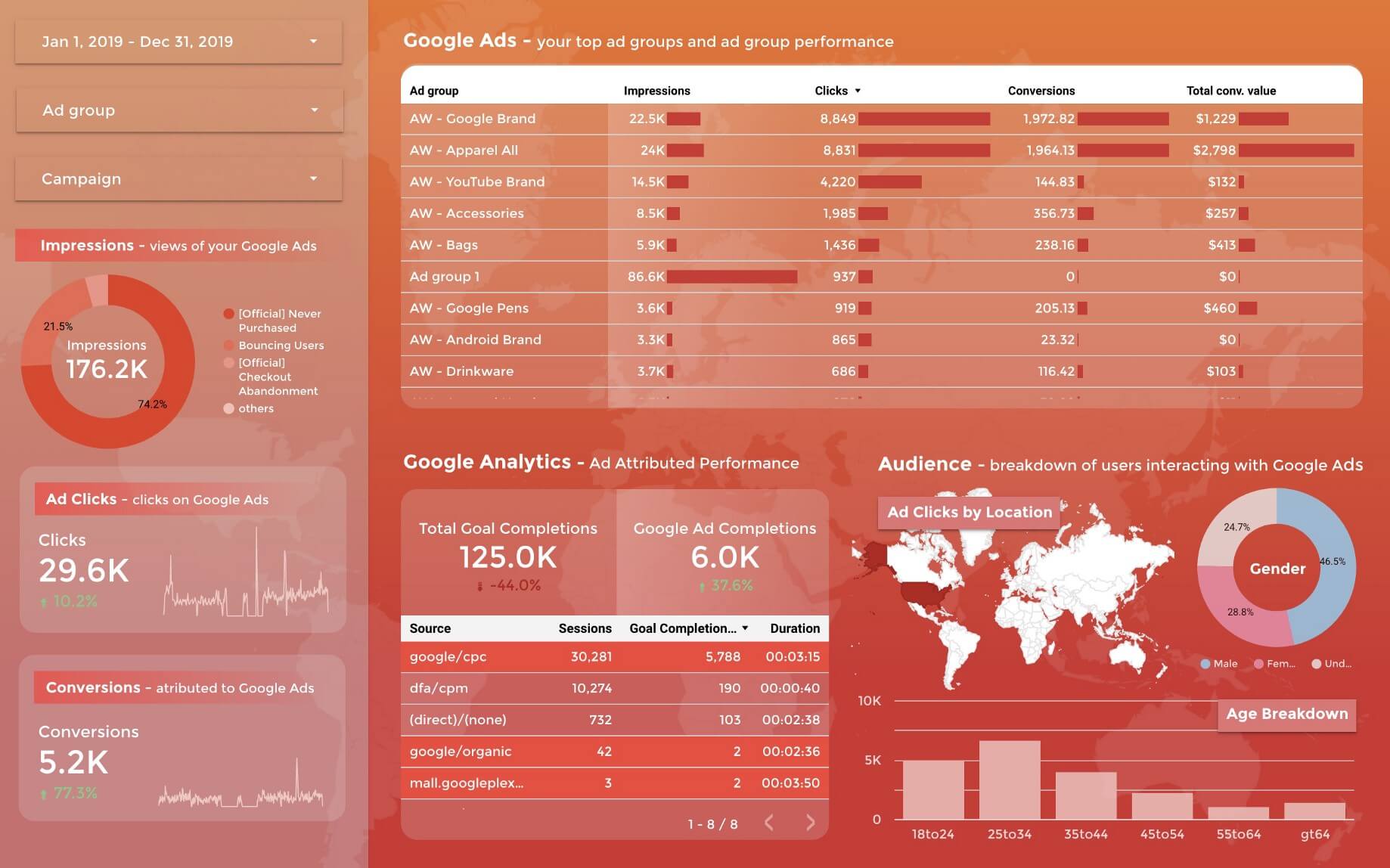
Conclusion
Creating a digital marketing plan for your small business needs should not be daunting.
With the eight steps we’ve outlined, you can develop a strategy that works best for you and helps you achieve your desired results.
You now know that a digital marketing plan is a document in which you strategically map out your digital marketing objectives, as well as the steps you’ll take to achieve those objectives.
Digital marketing plans outline the online channels you can use to reach and communicate with your target audience, such as online advertising, search engine optimisation, email marketing, and social media.
Which marketing channel will you plan to use, and why?
Let us know in the comments below!
Developing a strategy for success before diving into these strategies will give you an advantage when it comes time to execute them!
We would love to help create your first digital marketing plan for small business – Contact us today!
Have questions about any of the steps? Feel free to reach out to us for more information or assistance crafting your plan.
Are you looking for a digital marketing agency for small businesses in the UK? Dynamics Tech assists small businesses in managing many facets of their brand by improving sales, strategising marketing programs, and identifying the most effective technologies. Concentrate on what you do best, and we’ll handle the rest. Join our client list today!
